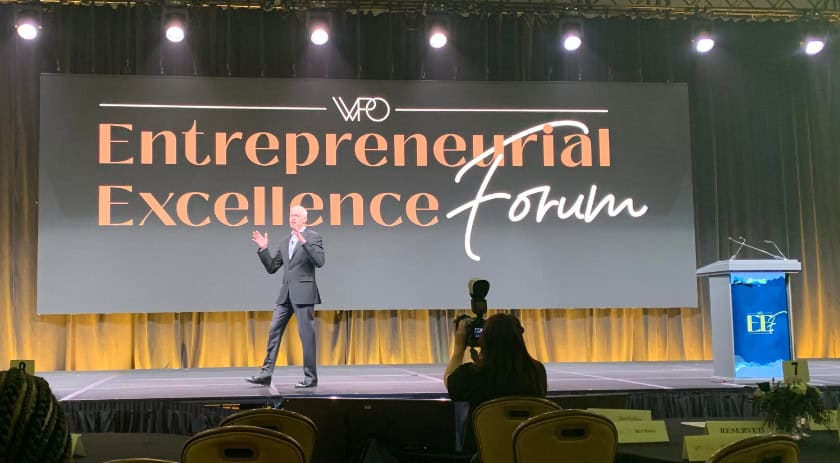12 Questions for Building a Great Company with Jim Collins
I had the distinct pleasure of learning from Jim Collins at the 2024 Women Presidents Organization Entrepreneurial Excellence Forum in Colorado Springs. Jim took the audience through the 12 key concepts from his books Good to Great, Built to Last, How the Mighty Fall, and Great by Choice. Here are the questions he shared and my own takeaways:
- Where are we on our journey to Level 5 leadership? For anyone familiar with Good to Great, you will recall that Level 5 leaders differentiate themselves with their humility combined with indomitable will. At The Roundtable, we think of this as moving away from the notion of ‘heroic’ leadership to focusing on the collective impact we make together.
- Do we practice ‘who’ not ‘what’? Great vision without great people is irrelevant. Get the right people on the bus and into the right seats. Career conversations that focus on strengths are critical. Spend less time being frustrated on what people aren’t and more time focused on being grateful for what they are.
- Where can you replace the Tyranny of the OR with the Genius of the AND? You have to be either compassionate or accountable; you need to be profitable or affordable; you need to be thoughtful or decisive. When we create false dichotomies, we get stuck in a false narrative. Challenge the ‘or’ and find the ‘and’.
- What are the brutal facts? Never confuse the need to confront the brutal facts with the unwavering faith that you will make it through. Blind optimism is not the answer. Informed optimism is.
- Do we make disciplined decisions within the three circles of our Hedgehog Concept? When it comes to leading, the advantage will go to those organizations who are driven by passion, know what they can be best in the world at and who understand what drives their economic engine. But remember, big does not equal great and great does not equal big.
- What is our flywheel and how far can it go? The flywheel is all about the cumulative effect that comes with staying the course. There are three criteria for a great flywheel: it has logic and momentum; it supports your purpose; and, it’s what you do. A good flywheel is your purpose combined with your fuel.
- Have we embraced the 20 Mile March discipline in every element of our flywheel? The 20-mile march is all about consistency. Explore how well you execute each element of your flywheel to speed up momentum and avoid getting stuck in the mud.
- What bullets and cannons should we fire to extend and renew our flywheel? All great companies extend their flywheel by calibrating into new areas. For example, the iPod was a bullet, the iPhone was the cannon. Where can you test boundaries with bullets before lobbing your cannonball?
- Where should we channel our productive paranoia to avoid the five stages of decline? With less than 15% of the F500 still on the list since its first publishing in 1955, the reality that your business will survive over the next number of decades is slim. And, a year after record sales, half of all bankruptcies occur. How much is leadership hubris a contributing factor here?
- Have we made the shift from time-telling to clock building? You can be a genius with a thousand helpers but if your company cannot be great without you, you don’t have a great company. This is critically important for leaders – whether you’re an entrepreneur, a CEO or the brilliant head of a division. If you walk away and everything falls apart, you’re a time teller, not a clock builder.
- How can we preserve the core and stimulate progress and do we need a BHAG? Preserving the core is about living into your core purpose and core values. Stimulating progress is about having a BHAG (big hairy audacious goal). And remember, 50-60% ability for success is the mark of a good BHAG.
- What is our return on luck – good or bad – and how can we increase it? How you make the most of actions that you didn’t cause, that came as a surprise and that had a significant impact (good or bad), are you can gage your return on luck. Sometimes the best things come from the worst times and how you leverage your learnings can make a substantial difference in the long run.
Jim Collins is a master thinker and presenter. I’m reenergized to reapply many of his principles into my leadership practice and I hope you are too. Be sure to pick up Good to Great if you haven’t read it. It stands the test of time.
And, enjoy this clip of Jim narrating a summary of his talk to an animation. Grateful to my colleague Cora who captured this.
If you would like to learn how you can cultivate Level 5 Leadership in your organization, we can help. Our proven system builds leaders that can move beyond the barriers of ego to create and unleash collective impact. We’d love to help you get there.




